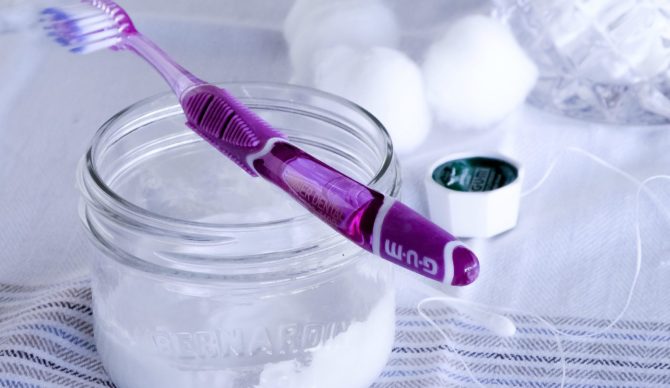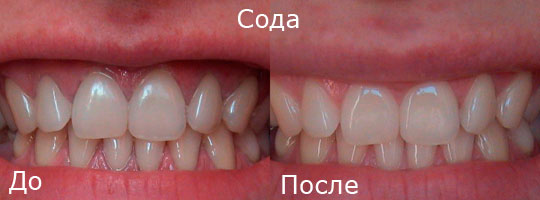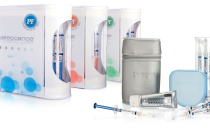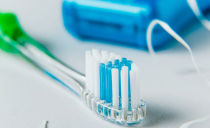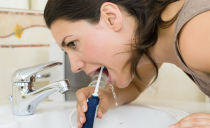How to brush your teeth with soda for whitening without harm
Everyone wants to sparkle a snow-white smile, but regular dental brushing at the dentist has become a habit for only a few, because it takes time and money. To save both you can brush your teeth with ordinary baking soda. Sodium chloride is one of the most affordable and well-known products for home whitening, but they must be used correctly, since an abrasive substance can harm tooth enamel.
Is it possible to whiten teeth with soda
Many people use soda powder, known for its abrasive property, to clean dishes and kitchen surfaces from old pollution. Based on this, it can be assumed that he will perfectly cope with plaque. Those who have already tested the effectiveness of the product in practice, argue that the enamel after its use really brightens.
Soda is known for its disinfecting property, due to which a solution of this substance is often used to rinse the mouth and throat with infections and inflammation of the mucous membranes. Soda treatment usually does not have any negative side effects, but if we consider in more detail the mechanism of cleaning the tooth surface, it turns out that teeth whitening with sodium chloride is achieved by removing the upper darkened enamel layer.
The dentition really brightens noticeably after brushing with soda, but for many this bleaching method causes bleeding of the gums and increased tooth sensitivity: a painful reaction to acidic, sweet, hot, cold foods.
Compliance with the rules of this procedure will help minimize the harm of such an aggressive cleaning.
How to brush your teeth with soda to whiten them
You can brush your teeth with baking soda to whiten them in many ways. The simplest is to use a dry powder of sodium chloride, which is distributed in a thin layer on the surface of the dentition, and then brush your teeth. After cleaning, you must remove the powder with a touch of light swabs with a cotton pad or soft cloth and rinse your mouth well with warm water.
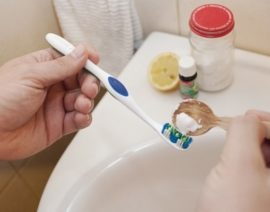 In the second method, soda powder is added directly to the toothpaste, then this mixture is placed on a soft toothbrush and brushed with it. It is better to use a paste that contains fluorine, which strengthens the enamel.
In the second method, soda powder is added directly to the toothpaste, then this mixture is placed on a soft toothbrush and brushed with it. It is better to use a paste that contains fluorine, which strengthens the enamel.
A slightly complicated, but more gentle option for whitening enamel is to apply soda powder on it, diluted with a few drops of water to a pulp consistency. When the correct consistency is reached, the soda will cease to dissolve. Remove the cleaning solution with gauze or cotton wool, and then rinse the mouth thoroughly with water.
To achieve the maximum brightening effect at home, you can brush your teeth with soda with additives that enhance the whitening function. Such auxiliary ingredients are lemon juice and hydrogen peroxide, which are also used as stand-alone bleaching agents.
To prepare a soda mixture with lemon juice or 3% peroxide, sodium chloride is diluted with several drops of these substances - each individually or both at the same time. But before using it, you need to check with your dentist whether it is harmful to brush your teeth with soda, supplemented with such substances. For example, the same acid does not easily cleanse and brighten, but also destroys enamel. The effect after its use will be impressive, but it is necessary to weigh all the risks - such cleaning is permissible in rare cases and only with an absolutely healthy dentition.
How to reduce the harmful effects of soda
Rules under which you can brush your teeth with soda without much harm:
- To apply soda bleach to enamel, you need to use a brush with soft bristles, and preferably a gauze swab, cotton pad or even a finger. The main thing is not a stiff brush, which, in combination with soda, severely injures the enamel and surrounding mucous membranes.
- In the application process, you should try to protect the gums and tongue from soda gruel to get in order to avoid drying and painful irritation of their mucous membranes.
- For several hours after cleaning, you can not eat hot and cold food, drinks.
- For several days before and after the procedure, you should brush your teeth with fluoride paste to accelerate the restoration of enamel.
How to fix the cleaning result and restore the enamel
To fix the whiteness effect, in the first days after cleaning, it is better not to include coloring products in the diet, since enamel during this period is especially prone to staining due to the roughness that soda leaves behind. Such products include beets and carrots, chocolate, oranges and tangerines, red meat, dark cereals and legumes, as well as drinks: cocoa, black tea, coffee, red wine and juices, colored soda. We must try to abandon cigarettes, otherwise the dentition will quickly turn yellow.
For the quickest restoration of dental tissues, it is useful to include in your daily diet containing natural fluoride, calcium cheeses and dairy products, nuts, white meat and fish.
How often can I brush my teeth with soda: benefits and harms
No matter how impressive the whitening effect of soda brushing is, the problem is that it does not last long, and it is often impossible to brush your teeth with soda - this method can be resorted to only in emergency situations.
Soda thinns tooth enamel layer by layer, exposing the underlying tissue - dentin, which can cause tooth decay. Knowing this property of soda, you can predict what will happen to the teeth if you clean them with this substance every day. According to dentists, such a procedure is dangerous to perform more than 1 time in 10 days.
As an alternative to sodium chloride, other whitening methods that allow you to lighten your teeth with less damage can be considered:
- activated carbon;
- pulp of strawberries;
- peeled banana;
- tea tree, lemon and grapefruit essential oils.
Do not forget about the regular use of whitening toothpaste, although it also can not be used too often: replacing a regular toothpaste with a tooth benefit is permissible no more than twice a week.
Any home whitening is not as harmless as it might seem if you do not delve into the essence of the process. Doctors do not recommend deep cleaning of teeth, the condition of which is doubtful. Even microscopic damage to enamel can quickly change its scale under the influence of abrasives. To verify the health of the teeth and the safety of their whitening is possible only at the dental examination, which must be done 2 times a year.
Professional brushing in a dentistry clinic may seem costly, but the effect of it lasts longer than from self-bleaching with improvised means, including brushing your teeth with soda. The specialist will not only whiten the visible part of the teeth, but also carefully remove the harmful accumulations of plaque in hard to reach places and the rudiments of tartar in the subgingival region.

